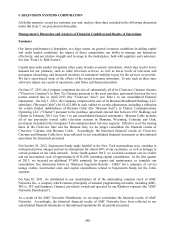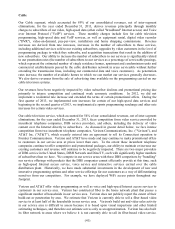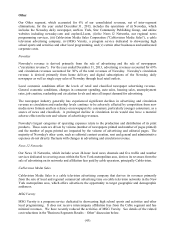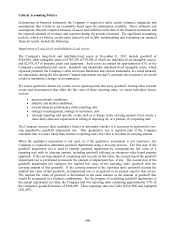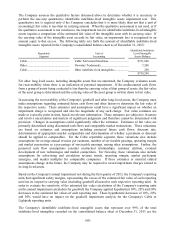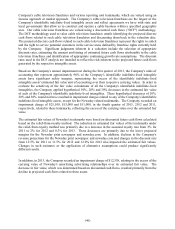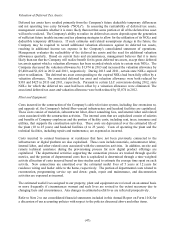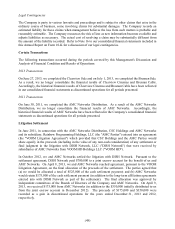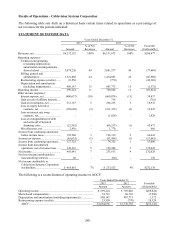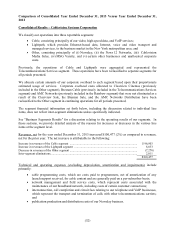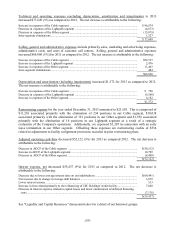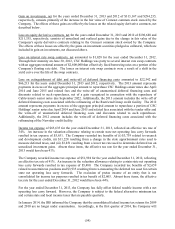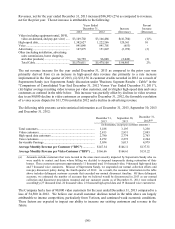Cablevision 2013 Annual Report Download - page 53
Download and view the complete annual report
Please find page 53 of the 2013 Cablevision annual report below. You can navigate through the pages in the report by either clicking on the pages listed below, or by using the keyword search tool below to find specific information within the annual report.(47)
Valuation of Deferred Tax Assets:
Deferred tax assets have resulted primarily from the Company's future deductible temporary differences
and net operating loss carry forwards ("NOLs"). In assessing the realizability of deferred tax assets,
management considers whether it is more likely than not that some portion or all of the deferred tax asset
will not be realized. The Company's ability to realize its deferred tax assets depends upon the generation
of sufficient future taxable income and tax planning strategies to allow for the utilization of its NOLs and
deductible temporary differences. If such estimates and related assumptions change in the future, the
Company may be required to record additional valuation allowances against its deferred tax assets,
resulting in additional income tax expense in the Company's consolidated statement of operations.
Management evaluates the realizability of the deferred tax assets and the need for additional valuation
allowances quarterly. Based on current facts and circumstances, management believes that it is more
likely than not that the Company will realize benefit for its gross deferred tax assets, except those deferred
tax assets against which a valuation allowance has been recorded which relate to certain state NOLs. The
Company decreased the valuation allowance by $1,974 in 2013 and increased the valuation allowance by
$5,480 and $1,822 in 2012 and 2011, respectively. During 2013 and 2011, certain state NOLs expired
prior to utilization. The deferred tax asset corresponding to the expired NOLs had been fully offset by a
valuation allowance. The associated deferred tax asset and valuation allowance were both reduced by
$303 and $425 in 2013 and 2011, respectively. Pursuant to certain LLC conversions during 2012, state
NOLs for which the deferred tax asset had been offset by a valuation allowance were eliminated. The
associated deferred tax asset and valuation allowance were both reduced by $3,074 in 2012.
Plant and Equipment:
Costs incurred in the construction of the Company's cable television system, including line extensions to,
and upgrade of, the Company's hybrid fiber-coaxial infrastructure and headend facilities are capitalized.
These costs consist of materials, subcontractor labor, direct consulting fees, and internal labor and related
costs associated with the construction activities. The internal costs that are capitalized consist of salaries
and benefits of Company employees and the portion of facility costs, including rent, taxes, insurance and
utilities, that supports the construction activities. These costs are depreciated over the estimated life of
the plant (10 to 25 years) and headend facilities (4 to 25 years). Costs of operating the plant and the
technical facilities, including repairs and maintenance, are expensed as incurred.
Costs incurred to connect businesses or residences that have not been previously connected to the
infrastructure or digital platform are also capitalized. These costs include materials, subcontractor labor,
internal labor, and other related costs associated with the connection activities. In addition, on-site and
remote technical assistance during the provisioning process for new digital product offerings are
capitalized. The departmental activities supporting the connection process are tracked through specific
metrics, and the portion of departmental costs that is capitalized is determined through a time weighted
activity allocation of costs incurred based on time studies used to estimate the average time spent on each
activity. New connections are amortized over the estimated useful lives of 5 years or 12 years for
residence wiring and feeder cable to the home, respectively. The portion of departmental costs related to
reconnection, programming service up- and down- grade, repair and maintenance, and disconnection
activities are expensed as incurred.
The estimated useful lives assigned to our property, plant and equipment are reviewed on an annual basis
or more frequently if circumstances warrant and such lives are revised to the extent necessary due to
changing facts and circumstances. Any changes in estimated useful lives are reflected prospectively.
Refer to Note 2 to our consolidated financial statements included in this Annual Report on Form 10-K for
a discussion of our accounting policies with respect to the policies discussed above and other items.





